Statistics Assignment: Hypothesis Testing Solutions - [University]
VerifiedAdded on 2023/01/11
|7
|1027
|33
Homework Assignment
AI Summary
This document provides solutions to a statistics assignment focusing on hypothesis testing. The solutions cover six different problems, each involving the formulation of null and alternative hypotheses, selection of appropriate test statistics (Z-test or T-test), calculation of p-values, and the drawing of conclusions based on the significance level. The assignment covers topics such as testing claims about population means, comparing variances, and analyzing sample proportions, including real-world scenarios such as temperature measurements, blood pressure variations, production defect rates, and response times of companies. The solutions provide step-by-step explanations, making it a valuable resource for students learning statistical analysis and hypothesis testing.
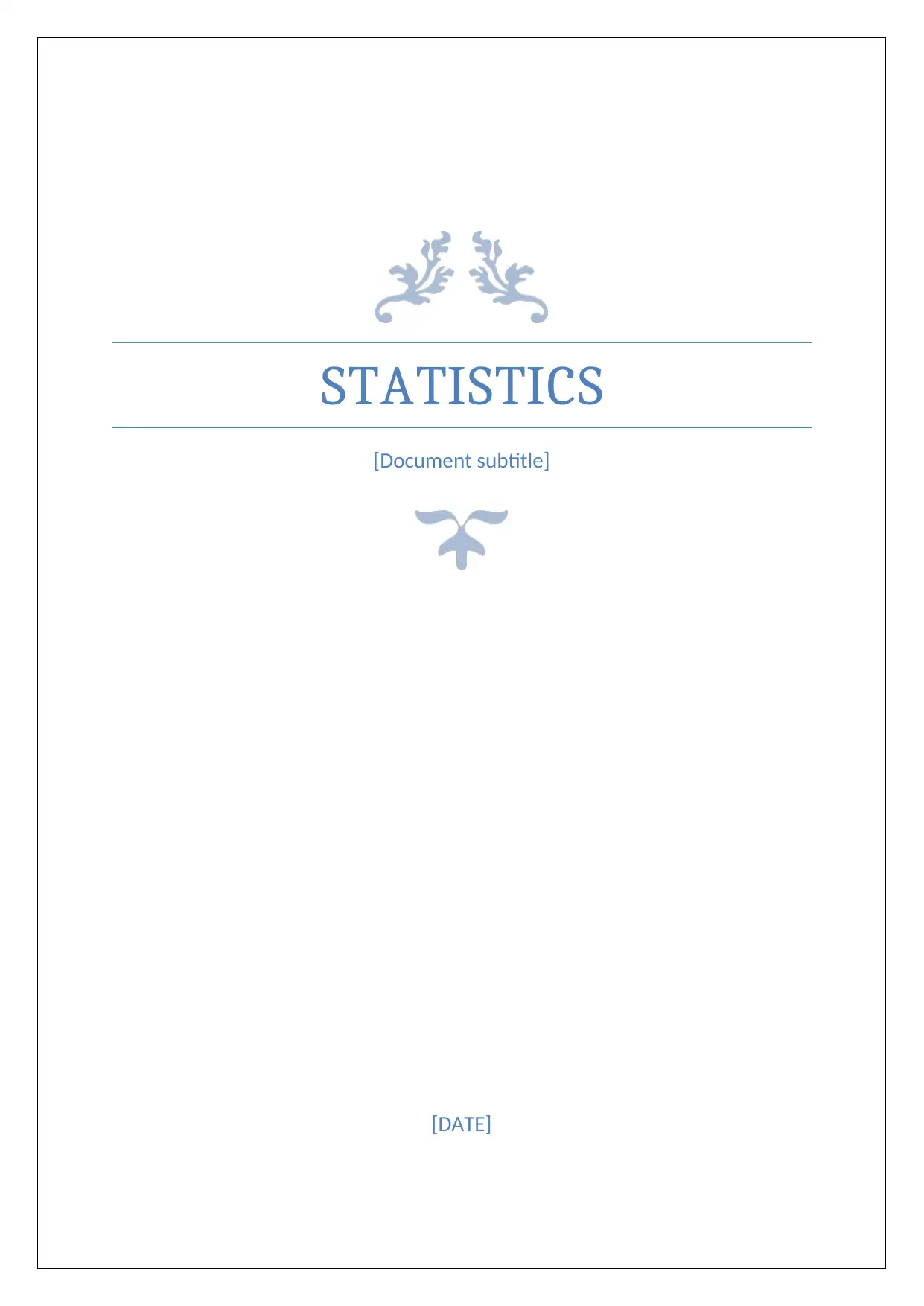
STATISTICS
[Document subtitle]
[DATE]
[Document subtitle]
[DATE]
Paraphrase This Document
Need a fresh take? Get an instant paraphrase of this document with our AI Paraphraser
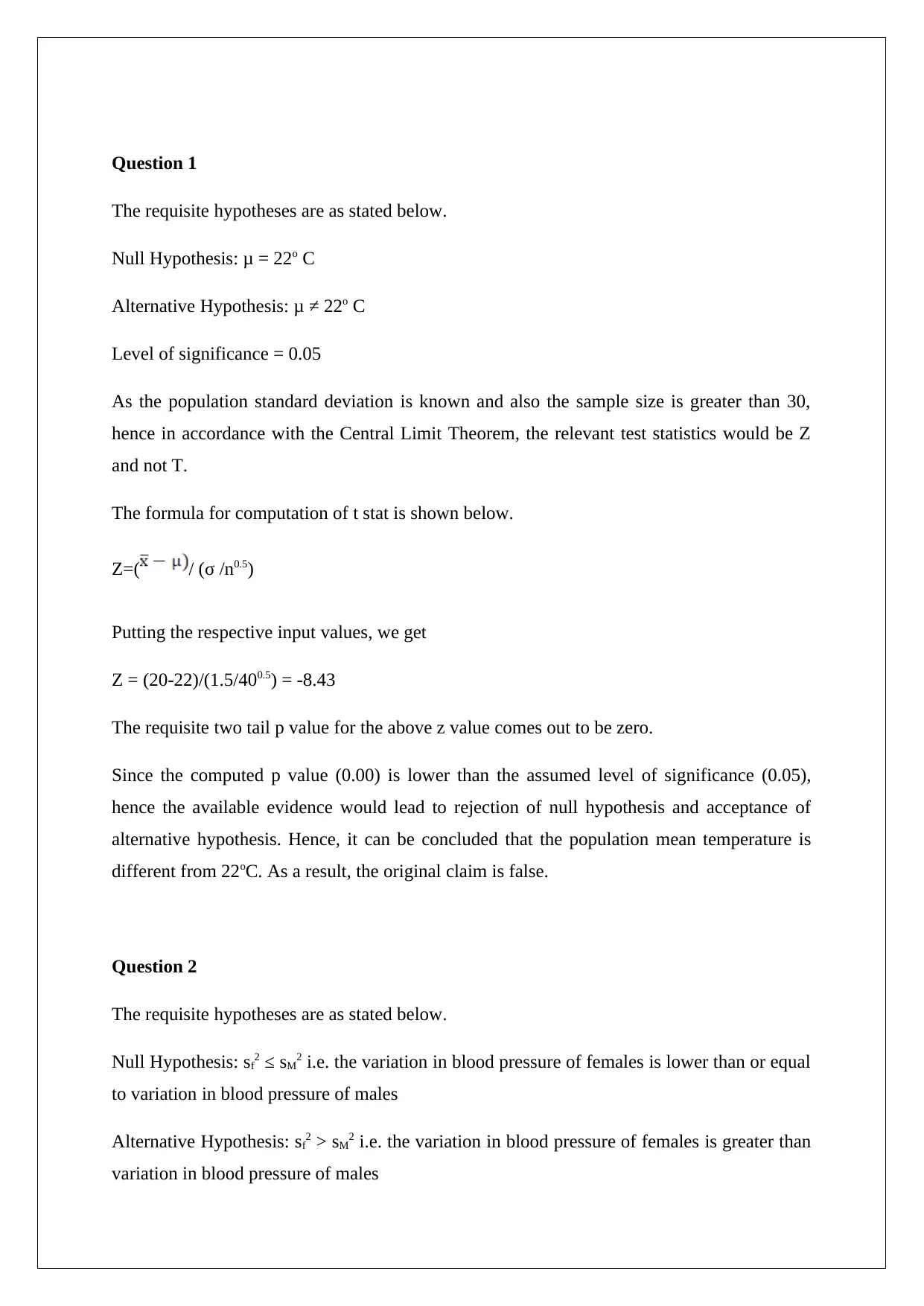
Question 1
The requisite hypotheses are as stated below.
Null Hypothesis: μ = 22o C
Alternative Hypothesis: μ ≠ 22o C
Level of significance = 0.05
As the population standard deviation is known and also the sample size is greater than 30,
hence in accordance with the Central Limit Theorem, the relevant test statistics would be Z
and not T.
The formula for computation of t stat is shown below.
Z=( / (σ /n0.5)
Putting the respective input values, we get
Z = (20-22)/(1.5/400.5) = -8.43
The requisite two tail p value for the above z value comes out to be zero.
Since the computed p value (0.00) is lower than the assumed level of significance (0.05),
hence the available evidence would lead to rejection of null hypothesis and acceptance of
alternative hypothesis. Hence, it can be concluded that the population mean temperature is
different from 22oC. As a result, the original claim is false.
Question 2
The requisite hypotheses are as stated below.
Null Hypothesis: sf2 ≤ sM2 i.e. the variation in blood pressure of females is lower than or equal
to variation in blood pressure of males
Alternative Hypothesis: sf2 > sM2 i.e. the variation in blood pressure of females is greater than
variation in blood pressure of males
The requisite hypotheses are as stated below.
Null Hypothesis: μ = 22o C
Alternative Hypothesis: μ ≠ 22o C
Level of significance = 0.05
As the population standard deviation is known and also the sample size is greater than 30,
hence in accordance with the Central Limit Theorem, the relevant test statistics would be Z
and not T.
The formula for computation of t stat is shown below.
Z=( / (σ /n0.5)
Putting the respective input values, we get
Z = (20-22)/(1.5/400.5) = -8.43
The requisite two tail p value for the above z value comes out to be zero.
Since the computed p value (0.00) is lower than the assumed level of significance (0.05),
hence the available evidence would lead to rejection of null hypothesis and acceptance of
alternative hypothesis. Hence, it can be concluded that the population mean temperature is
different from 22oC. As a result, the original claim is false.
Question 2
The requisite hypotheses are as stated below.
Null Hypothesis: sf2 ≤ sM2 i.e. the variation in blood pressure of females is lower than or equal
to variation in blood pressure of males
Alternative Hypothesis: sf2 > sM2 i.e. the variation in blood pressure of females is greater than
variation in blood pressure of males

Level of significance = 0.05
The relevant test statistic for the given case would be F value
Test statistic i.e. F value = sf2 / sM2 = 22.72/20.12 = 1.275
The critical value for F with df1 = 15, df2 = 16 and level of significance = 0.05 comes out as
2.35
Since computed test statistic is lower than F critical value, hence the available evidence
would not lead to rejection of null hypothesis and acceptance of alternative hypothesis. Thus,
it can be concluded that the variation in blood pressure of females is lower than or equal to
variation in blood pressure of males.
Question 3
Step 1
Null hypothesis Production process is not out of control when defect does not
exceed 3%.
Alternative hypothesis Production process is out of control when defect does
exceed 3%.
Step 2
Significance level = 0.01
Step 3
The z stat would be computed as shown below.
Sample proportion P= 5.9%
Sample size = 85 items
The relevant test statistic for the given case would be F value
Test statistic i.e. F value = sf2 / sM2 = 22.72/20.12 = 1.275
The critical value for F with df1 = 15, df2 = 16 and level of significance = 0.05 comes out as
2.35
Since computed test statistic is lower than F critical value, hence the available evidence
would not lead to rejection of null hypothesis and acceptance of alternative hypothesis. Thus,
it can be concluded that the variation in blood pressure of females is lower than or equal to
variation in blood pressure of males.
Question 3
Step 1
Null hypothesis Production process is not out of control when defect does not
exceed 3%.
Alternative hypothesis Production process is out of control when defect does
exceed 3%.
Step 2
Significance level = 0.01
Step 3
The z stat would be computed as shown below.
Sample proportion P= 5.9%
Sample size = 85 items
⊘ This is a preview!⊘
Do you want full access?
Subscribe today to unlock all pages.

Trusted by 1+ million students worldwide
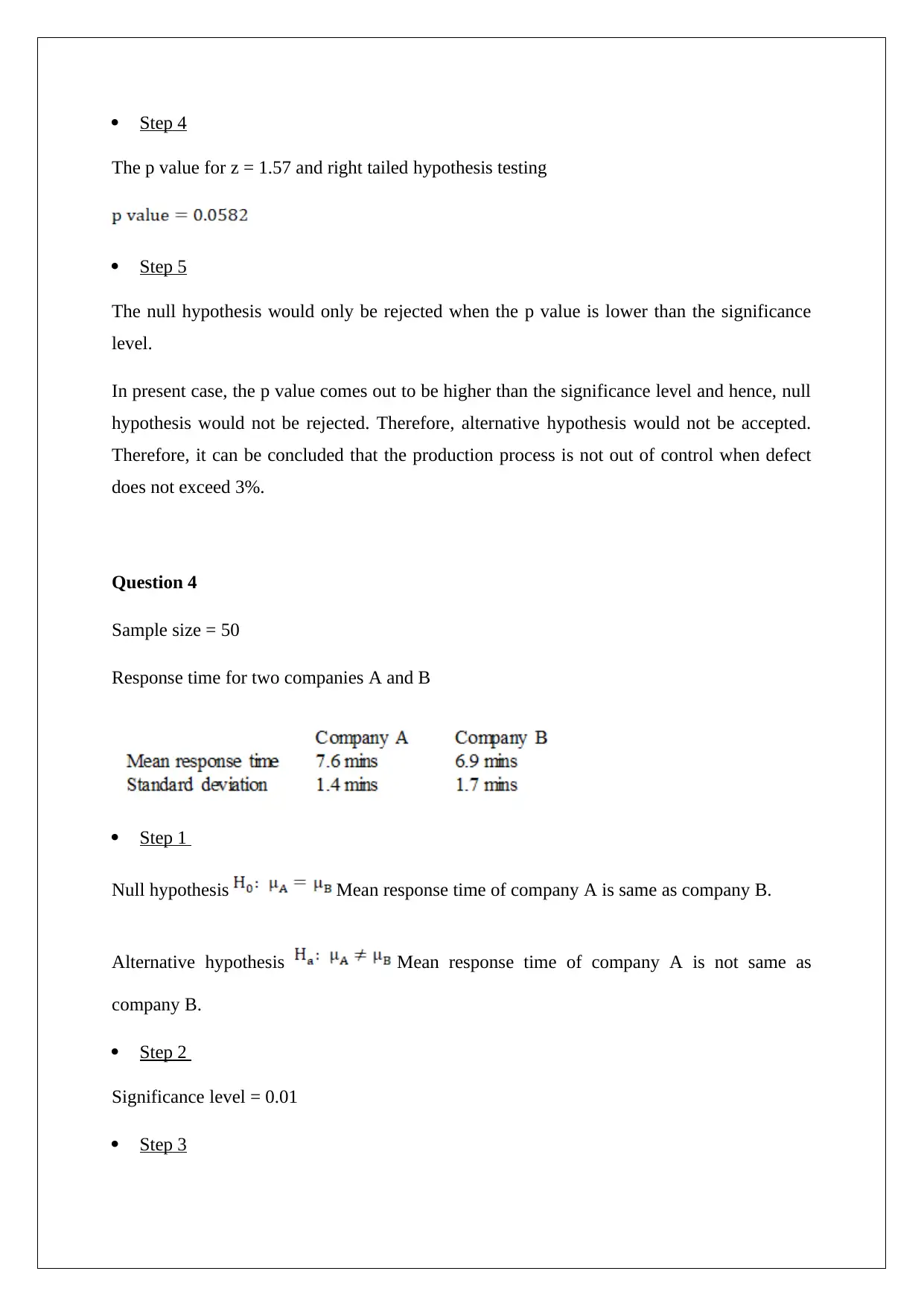
Step 4
The p value for z = 1.57 and right tailed hypothesis testing
Step 5
The null hypothesis would only be rejected when the p value is lower than the significance
level.
In present case, the p value comes out to be higher than the significance level and hence, null
hypothesis would not be rejected. Therefore, alternative hypothesis would not be accepted.
Therefore, it can be concluded that the production process is not out of control when defect
does not exceed 3%.
Question 4
Sample size = 50
Response time for two companies A and B
Step 1
Null hypothesis Mean response time of company A is same as company B.
Alternative hypothesis Mean response time of company A is not same as
company B.
Step 2
Significance level = 0.01
Step 3
The p value for z = 1.57 and right tailed hypothesis testing
Step 5
The null hypothesis would only be rejected when the p value is lower than the significance
level.
In present case, the p value comes out to be higher than the significance level and hence, null
hypothesis would not be rejected. Therefore, alternative hypothesis would not be accepted.
Therefore, it can be concluded that the production process is not out of control when defect
does not exceed 3%.
Question 4
Sample size = 50
Response time for two companies A and B
Step 1
Null hypothesis Mean response time of company A is same as company B.
Alternative hypothesis Mean response time of company A is not same as
company B.
Step 2
Significance level = 0.01
Step 3
Paraphrase This Document
Need a fresh take? Get an instant paraphrase of this document with our AI Paraphraser

The z stat would be computed as shown below.
Step 4
The p value for z = 2.25 and two tailed hypothesis testing
Step 5
The null hypothesis would only be rejected when the p value is lower than the significance
level.
In present case, the p value comes out to be higher than the significance level and hence, null
hypothesis would not be rejected. Therefore, alternative hypothesis would not be accepted.
Therefore, it can be concluded that the mean response time of company A is same as
company B.
Question 5
Competitors scores before and after training
Sample size = 7 gymnasts
Step 1
Null hypothesis Mean scores of gymnasts before and after training is
same.
Alternative hypothesis Mean scores of gymnasts before is lower than
after training.
Step 4
The p value for z = 2.25 and two tailed hypothesis testing
Step 5
The null hypothesis would only be rejected when the p value is lower than the significance
level.
In present case, the p value comes out to be higher than the significance level and hence, null
hypothesis would not be rejected. Therefore, alternative hypothesis would not be accepted.
Therefore, it can be concluded that the mean response time of company A is same as
company B.
Question 5
Competitors scores before and after training
Sample size = 7 gymnasts
Step 1
Null hypothesis Mean scores of gymnasts before and after training is
same.
Alternative hypothesis Mean scores of gymnasts before is lower than
after training.
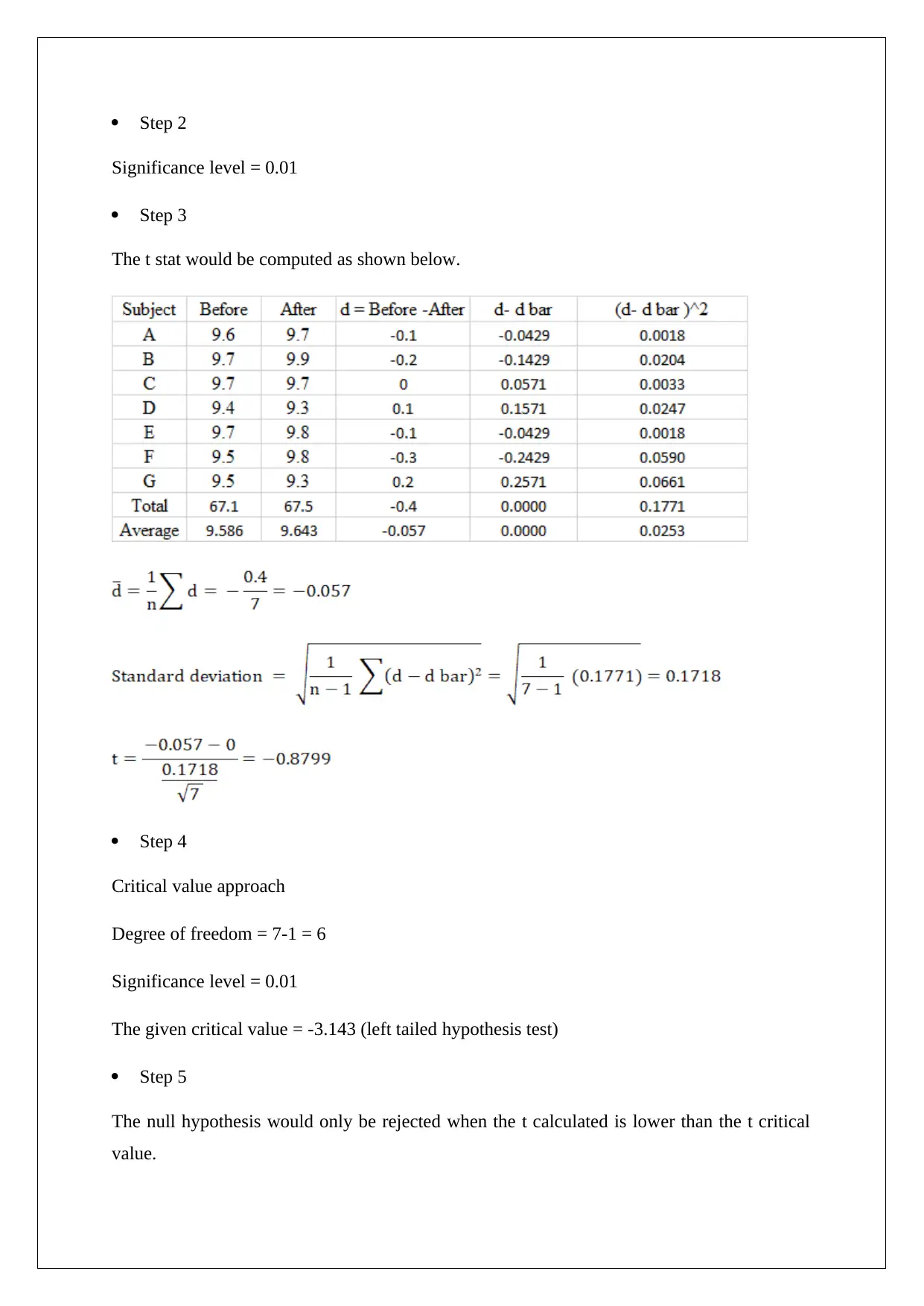
Step 2
Significance level = 0.01
Step 3
The t stat would be computed as shown below.
Step 4
Critical value approach
Degree of freedom = 7-1 = 6
Significance level = 0.01
The given critical value = -3.143 (left tailed hypothesis test)
Step 5
The null hypothesis would only be rejected when the t calculated is lower than the t critical
value.
Significance level = 0.01
Step 3
The t stat would be computed as shown below.
Step 4
Critical value approach
Degree of freedom = 7-1 = 6
Significance level = 0.01
The given critical value = -3.143 (left tailed hypothesis test)
Step 5
The null hypothesis would only be rejected when the t calculated is lower than the t critical
value.
⊘ This is a preview!⊘
Do you want full access?
Subscribe today to unlock all pages.

Trusted by 1+ million students worldwide
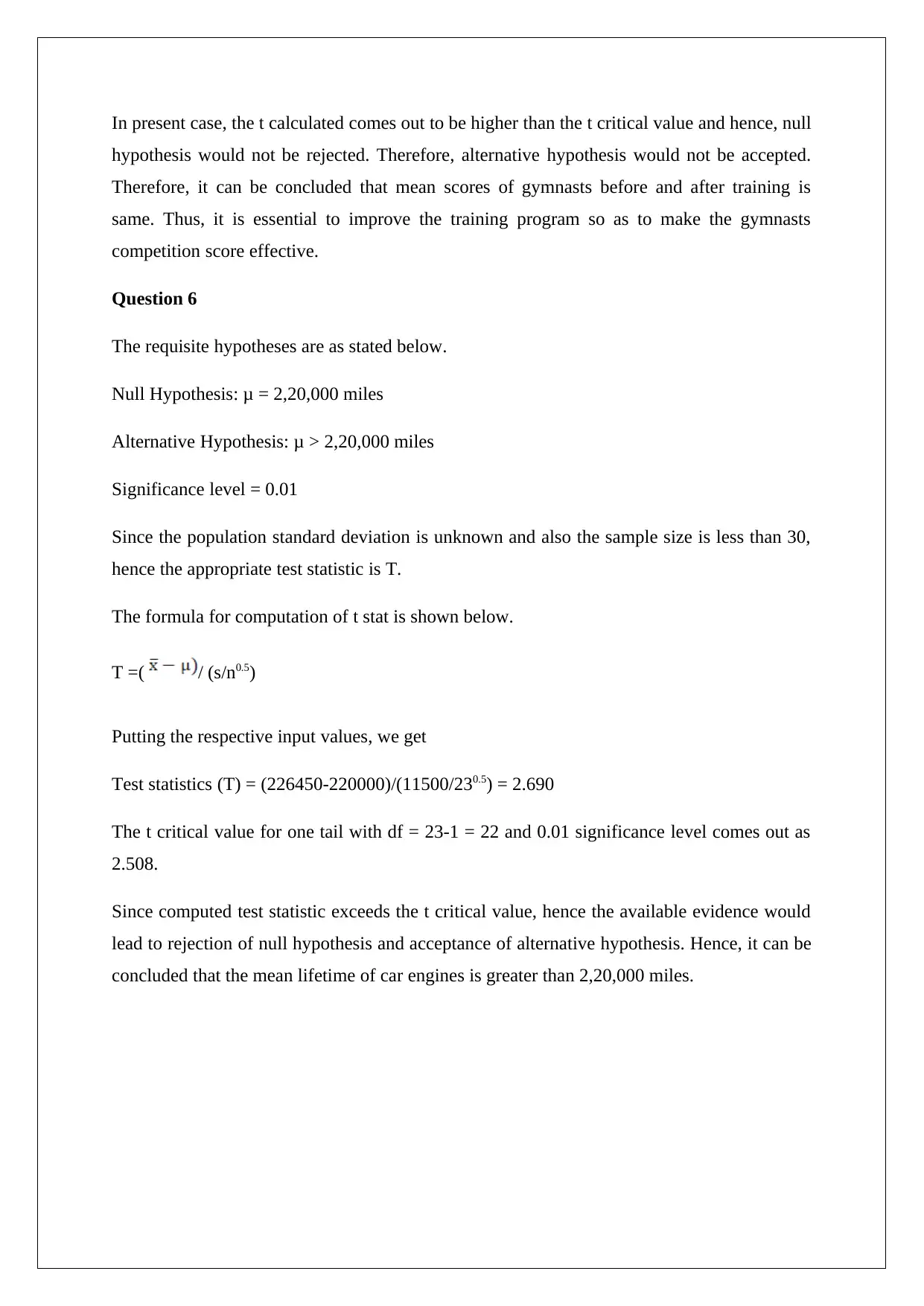
In present case, the t calculated comes out to be higher than the t critical value and hence, null
hypothesis would not be rejected. Therefore, alternative hypothesis would not be accepted.
Therefore, it can be concluded that mean scores of gymnasts before and after training is
same. Thus, it is essential to improve the training program so as to make the gymnasts
competition score effective.
Question 6
The requisite hypotheses are as stated below.
Null Hypothesis: μ = 2,20,000 miles
Alternative Hypothesis: μ > 2,20,000 miles
Significance level = 0.01
Since the population standard deviation is unknown and also the sample size is less than 30,
hence the appropriate test statistic is T.
The formula for computation of t stat is shown below.
T =( / (s/n0.5)
Putting the respective input values, we get
Test statistics (T) = (226450-220000)/(11500/230.5) = 2.690
The t critical value for one tail with df = 23-1 = 22 and 0.01 significance level comes out as
2.508.
Since computed test statistic exceeds the t critical value, hence the available evidence would
lead to rejection of null hypothesis and acceptance of alternative hypothesis. Hence, it can be
concluded that the mean lifetime of car engines is greater than 2,20,000 miles.
hypothesis would not be rejected. Therefore, alternative hypothesis would not be accepted.
Therefore, it can be concluded that mean scores of gymnasts before and after training is
same. Thus, it is essential to improve the training program so as to make the gymnasts
competition score effective.
Question 6
The requisite hypotheses are as stated below.
Null Hypothesis: μ = 2,20,000 miles
Alternative Hypothesis: μ > 2,20,000 miles
Significance level = 0.01
Since the population standard deviation is unknown and also the sample size is less than 30,
hence the appropriate test statistic is T.
The formula for computation of t stat is shown below.
T =( / (s/n0.5)
Putting the respective input values, we get
Test statistics (T) = (226450-220000)/(11500/230.5) = 2.690
The t critical value for one tail with df = 23-1 = 22 and 0.01 significance level comes out as
2.508.
Since computed test statistic exceeds the t critical value, hence the available evidence would
lead to rejection of null hypothesis and acceptance of alternative hypothesis. Hence, it can be
concluded that the mean lifetime of car engines is greater than 2,20,000 miles.
1 out of 7
Related Documents
Your All-in-One AI-Powered Toolkit for Academic Success.
+13062052269
info@desklib.com
Available 24*7 on WhatsApp / Email
![[object Object]](/_next/static/media/star-bottom.7253800d.svg)
Unlock your academic potential
Copyright © 2020–2025 A2Z Services. All Rights Reserved. Developed and managed by ZUCOL.





